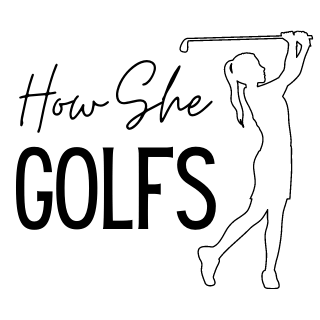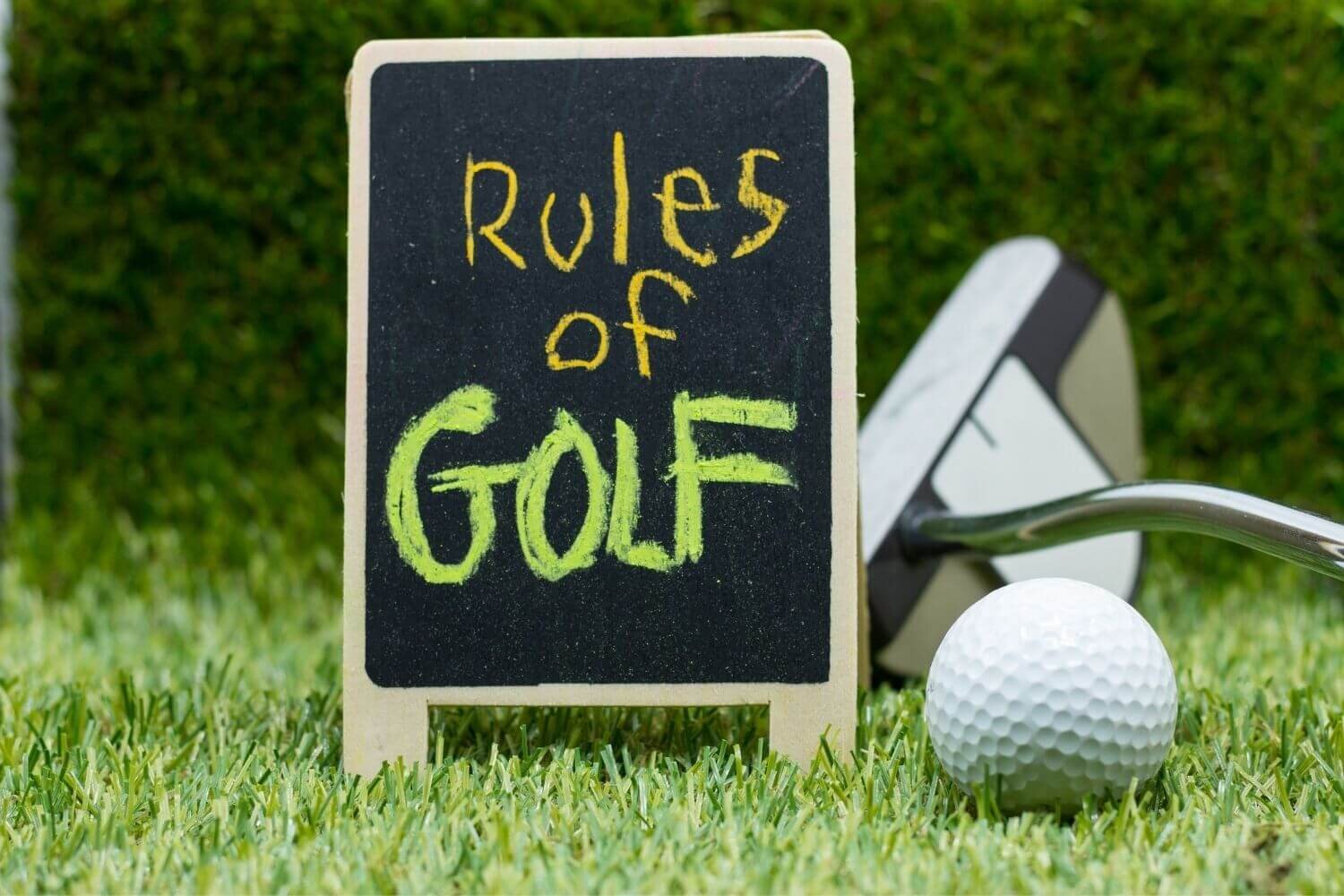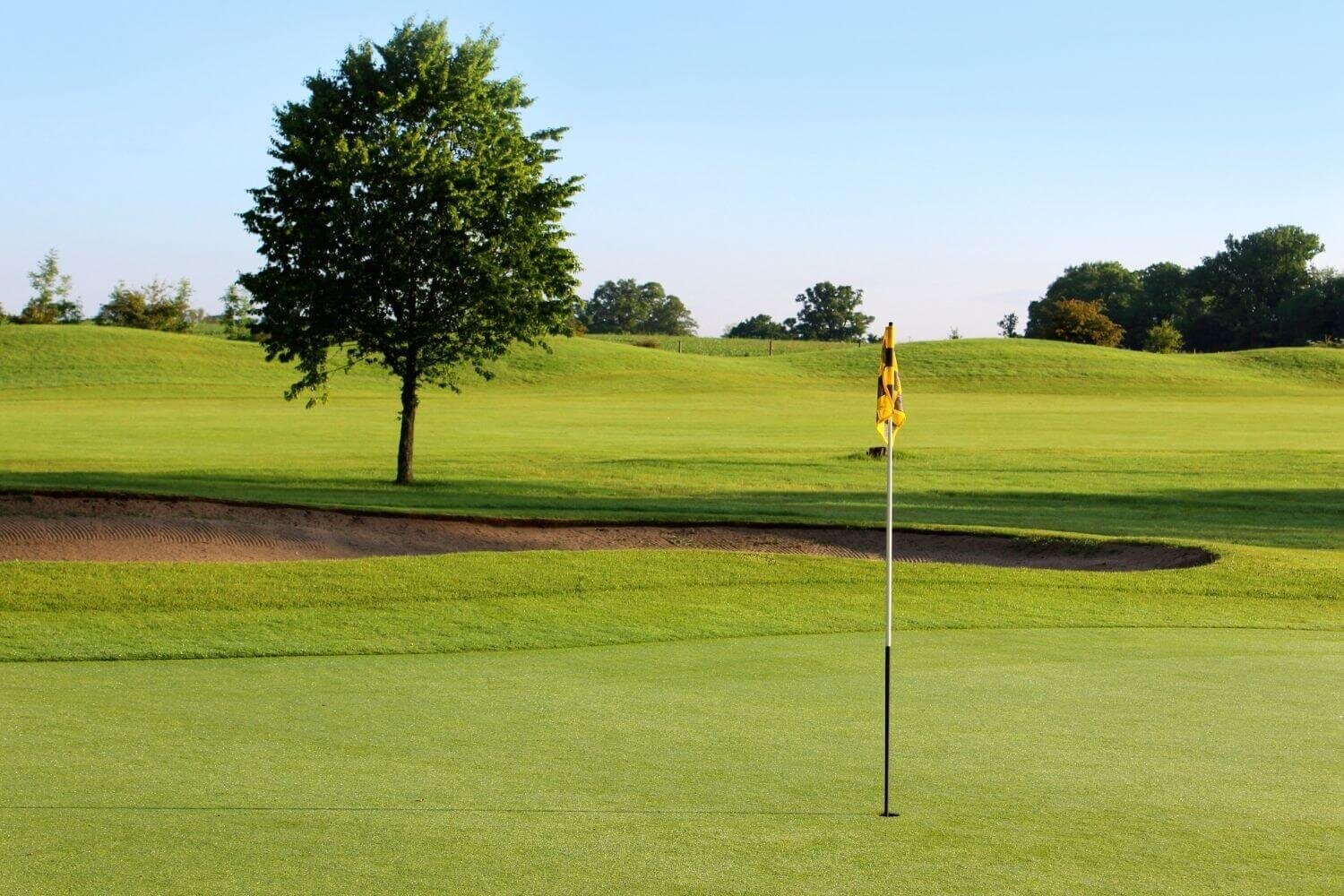21 Basic Golf Rules For Beginners To Learn
The earliest known written rules for golf date back to 1744. They were drafted by The Honourable Company of Edinburgh Golfers. Originally known as the “Articles & Laws in Playing at Golf”, they are known today as the “13 Articles”. The principles of those rules still fundamentally represent the same sport that is played today.
The United States Golf Association (USGA) and The R&A govern the sport of golf worldwide. Every four years, the R&A and USGA publish The Rules of Golf and the Rules of Amateur Status to define how the game is to be played.
In this post, you will find out what the basic golf rules are that all beginners should know when playing a casual game.
Rules Of Golf
The Game
Golf is a sport which is played by hitting a ball with a club on a golf course, to land the ball into a series of holes, in as few strokes as possible. Each hole starts by hitting your ball from the teeing area and ends when you’ve made it in the hole, which is located on the putting green.
RELATED POST: Golf Club Distances For Women Golfers
Player Conduct
There are three main standards players are expected to follow:
Play by the rules and act with integrity
Be considerate to other players
Take good care of the course
It’s a good idea to check with the person or group in charge of the course to find out if they have their own Code Of Conduct or dress code that you must follow to avoid penalties.
Be careful if you’re choosing funny golf team names for an event, as there might be some that are considered inappropriate.
PLAYING BY THE RULES
If you violate a rule, you must be honest and assign your own penalty.
A penalty applies when a rule is broken as a result of your actions, your caddie’s actions, or those of another person acting under your authority.
The Three Main Penalty Levels Are:
One-Stroke Penalty
General Penalty
Disqualification
One example of something that could result in a penalty is hitting another player’s ball. Golf ball markings will help you avoid making that mistake.
Read more for the most common penalties under the rules of golf.
The Course
Any area that is not defined on a golf course is considered out-of-bounds.
The Five Areas Of A Course Are:
The teeing area where you begin play of a hole
Penalty areas such as bodies of water or other areas where a ball is unable to be played
Bunkers which are man-made penalty areas filled with sand
The putting green where you end play of the hole
General areas which is any area of the course not described above
It is important to know which area your ball lies on as it affects the rules that would apply.
Equipment
Clubs & Balls
Clubs: You are not allowed to carry more than 14 clubs and usually aren’t allowed to replace lost or damaged clubs. You can choose the combination you bring, just make sure the clubs are conforming. You don’t need to have 14 clubs but it’s a good idea to bring them so you have enough options. There are certain clubs that are better for beginner golfers.
Balls: You must finish a hole with the ball you started it with unless you lose or damage a ball during a hole and need to replace it. Once the hole is completed, you can switch to a new ball before the start of the next hole.
RELATED POST: Golf Ball Size: Everything You Need To Know
If it meets the equipment rules, you can use certain equipment (golf towels, gloves, distance-measuring device, powders or drying agents, etc.) to help your play during a round as long as it doesn’t create an unfair advantage.
RELATED POST: How Many Clubs Are Allowed In A Golf Bag?
Gameplay
A round of golf consists of 18 or fewer holes played in order. Except on a par 3 golf course, they usually have only 9 holes. You must start your round on time to avoid penalties. Your ball must be placed inside the teeing area for your first stroke. A hole starts when you make your first stroke.
Practicing
You cannot practice while playing a hole or between two holes with a few exceptions:
You are practicing putting or chipping from the practice green.
You are practicing on or near the putting green of the hole you just completed.
You are practicing on the teeing area of your next hole.
Golf is meant to be played at a prompt pace. You must not be unreasonably delaying play. Take time to practice at home or at a driving range as much as you need to so you can keep up.
Ball Search
You get three minutes to fairly search for your ball, after that, it is considered lost.
Identifying Your Ball
Before you start a round, use something to mark your ball so you can identify it easily. You can identify your ball by seeing where it lands or finding your mark on the ball. If you have to lift it to check it, you must place a marker in its spot and replace it when you’re are done. If you accidentally move it from its original spot, put it back where it belongs.
Taking Turns
You can either choose the player with the lowest handicap in the teeing area to tee off first or flip a coin. After all players have begun, the ball that is farthest from the hole should determine who plays first. If you’re not playing out of turn to give someone an advantage, there is no penalty for doing so if you agree to let someone else go next.
Play The Ball As It Lies
You must play your ball from the spot it came to rest. You are not allowed to make unfair changes to the ball or its surroundings to give you an advantage. There are exceptions to this rule such as if the wind moves your ball, you can play it from the new spot.
Play The Course As You Find It
Same as playing the ball as it lies, playing the course as you find it means not changing its conditions to give yourself an unfair advantage. There are some situations where you are allowed to move objects or obstructions that interfere with your game through no fault of your own.
These include:
Loose impediments: Natural objects such as branches and sticks.
Moveable obstructions: Anything man-made or artificial that can be easily moved.
Abnormal course conditions: Such as temporary water which accumulated from heavy rains.
When this happens, you get free relief (relief with no penalty). You can drop your original ball or a new ball in a specified relief area according to the rules.
Fairly Striking The Ball
When making a stroke, you cannot push, scoop, or scrape the ball. You must hit the ball fairly by making minimum contact between the club and the ball. You cannot anchor the club by holding it against your stomach or chest. The ball should be still before you strike it.
Putting Green
Your ball is in the green if it touches it or is on something inside of the edge of the putting green. You may mark your ball and lift it to be cleaned. You are allowed to remove sand and loose soil and take reasonable actions to repair damage on the green without penalty. You have the option to either keep the flagstick in place or to remove it from the hole when you’re putting but you must decide before making the stroke.
RELATED POST: Golf Swing Tips
Unplayable Ball
If your ball comes to rest in a spot that’s not a penalty area and you deem it unplayable, you have a few options:
Go back to the spot of your previous stroke and play again.
Go back as far as you’d like while keeping the original position of the ball between you and the hole and drop a ball behind where the ball currently lies.
Drop anywhere within two club-lengths of where your ball lies, no closer to the hole.
Penalty Area
You may either play the ball as it lies without penalty or play the ball from outside the penalty area by taking penalty relief. Penalty areas are either marked yellow or red and there are certain relief options for both areas.
Dropping Your Ball
You must drop your ball when taking relief from a penalty area or an unplayable ball. It must be dropped by you or your partner, straight down from knee height, and must land and remain in the relief area.
Out Of Bounds
The player must add a one-stroke penalty and play the original ball or another ball from where the previous stroke was made.
Advice
You are only allowed to ask for advice from your partner or caddie and to give advice to your partner. You can wish a golfer good luck as much as you’d like to but you are not allowed to help someone play their golf shot. You are only allowed to discuss things that are commonly known such as the rules or distances from one object to another.
Scoring
There are two basic scoring methods in golf called “stroke play” and “match play.”
Stroke Play: The golfer writes the score for each hole in the designated spot on the scorecard. You add up all strokes throughout the game. In casual play, one person is usually assigned to keep score for everyone.
Match Play: Each hole counts as one point. Whoever gets the best score on a specific hole earns that point. The winner is the player, or team, with the most points at the end of play.
RELATED POSTS: Stroke Play vs Match Play
There are several other golf formats that add a fun twist to the game. Take Skins scoring for example, where players earn skins for winning each hole, which are often assigned a monetary value. This adds an exciting element to the game that makes it even more challenging.
It’s important to follow the rules whether you are golfing alone or with a group. The rules of golf can be complicated and change depending on the format, so you’ll need to understand these basics along with golf terminology for the best chance at navigating your way through the game.






